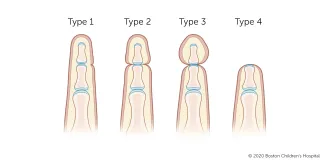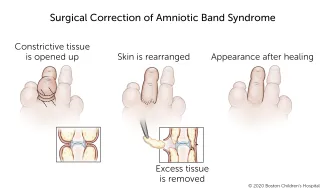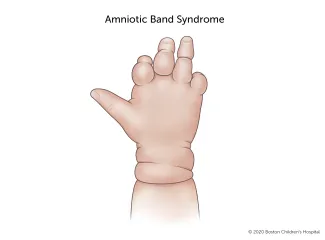Amniotic Band Syndrome | Symptoms & Causes
What are the symptoms of amniotic band syndrome?
The amniotic band might only cause a small dent around a finger or limb. But deeper bands can cause serious swelling, cut off of the flow of blood, or keep that part of the body from growing the right way. If a band is tight enough, the constriction may cause an in utero (before birth) amputation (part of the body coming off).

What causes amniotic band syndrome?
The exact cause of the syndrome is not known. Doctors do not think amniotic band syndrome is hereditary (passed from parent to child). Many cases seem to happen for no clear reason.
Amniotic Band Syndrome | Diagnosis & Treatments
How is amniotic band syndrome diagnosed?
Amniotic band syndrome is sometimes diagnosed before birth with an ultrasound test. Most of the time, it is seen when a baby is born. Your child may have an x-ray to help find out how serious the problem is.
How is amniotic band syndrome treated?
Treatment is different for every child. Some shallow bands may not interfere with function and may not require surgery. If your child has a deeper amniotic band, they may need one or more surgeries to help fix the way their hand looks and moves.

If your child needs surgery, it will probably be done when they are 1 year old or older. But if the constriction is limiting blood flow, they might need surgery right away.
How we care for amniotic band syndrome
The Orthopedic Center’s Hand and Orthopedic Upper Extremity Program and our Department of Plastic and Oral Surgery's Hand and Reconstructive Microsurgery Program have treated thousands of babies and children with amniotic band syndrome and other hand problems. We are experienced treating conditions that range from routine to highly complex, and can provide your child with expert diagnosis, treatment, and care. We also offer the benefits of some of the most advanced clinical and scientific research in the world.
Our Orthopedic Center is nationally known as the preeminent center for the care of children and young adults with a wide range of developmental, congenital, neuromuscular, sports-related, traumatic, and post-traumatic problems of the musculoskeletal system.
Our Department of Plastic and Oral Surgery is one of the largest and most experienced pediatric plastic and oral surgery centers anywhere in the world. We provide comprehensive care and treatment for a wide variety of congenital and acquired conditions, including hand deformities.


